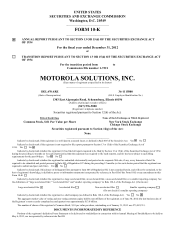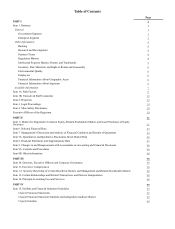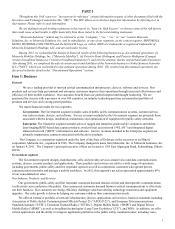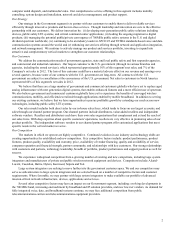Motorola 2012 Annual Report Download - page 13
Download and view the complete annual report
Please find page 13 of the 2012 Motorola annual report below. You can navigate through the pages in the report by either clicking on the pages listed below, or by using the keyword search tool below to find specific information within the annual report.5
spectrum on June 12, 2009. As a result of this transition, 108 MHz of spectrum historically used for broadcast television,
known as the 700MHz band, is being redeveloped and deployed for new uses (the so-called “digital dividend” spectrum),
including broadband and narrowband wireless communications. Now that the 700 MHz band spectrum is open nationwide,
FCC records indicate that so far over 170 public safety agencies throughout over 30 states have been deploying narrowband
operations at 700 MHz and others are in the planning stages.
Thirty-four MHz of spectrum in the 700 MHz band is now allocated to support new public safety narrowband and
broadband communications systems. This includes 24 MHz of spectrum previously allocated by the FCC and an additional ten
MHz of spectrum (the “D block”) allocated in February 2012. This latter ten MHz allocation is the result of Congressional
action responding to public safety requests for additional broadband spectrum.
The resulting law, Public Law 112-96 also identified up to $7 billion in funding for the nationwide public safety
broadband network with $2 billion of that available near-term. Pursuant to this law, a governance structure and entity known as
the First Responder Network Authority ("FirstNet") was established in August 2012 to manage deployment and operation of the
network. Additional work, currently ongoing in FirstNet, is required to enable deployment of the nationwide public safety
broadband network. As a result of the legislation and establishment of FirstNet, the FCC cancelled 21 conditional waiver
grants previously issued to public safety agencies to deploy 700 MHz broadband systems and instead established a new process
to issue special temporary authorizations ("STAs”) for early deployments. This required public safety entities to apply for early
deployment using the new process, and required that they be able to substantiate progress toward deployment. This creates a
higher standard than that used for the waivers, potentially affecting several of our customers. In September 2012, one such
customer, the State of Texas received an STA for deployment of 14 broadband sites in the Harris County area around Houston,
and we are in the process of implementing that broadband system. FirstNet is considering the potential for additional early
deployments, some by other of our customers, such as the State of Mississippi. Such early deployments would help speed
interoperable broadband capabilities for first responders and the experience gained regarding public safety broadband operation
should benefit FirstNet in developing and implementing its plan to deploy the nationwide network. The planned
implementation of a nationwide public safety network and any additional early deployments may also create opportunities for
our broadband solutions.
In March, 2012, Canada released a decision to allocate ten MHz of spectrum in the 700 MHz band for public safety
broadband. Subsequently, in August 2012, Canada proposed that an additional and adjacent ten MHz also be allocated to
public safety for broadband use. A decision on that additional ten MHz of spectrum is expected in 2013. If adopted, this would
harmonize Canada's 700 MHz band plan with that in the U.S.
Internationally, the ITU World Radio Conference ("WRC") was held in Geneva during the first quarter of 2012. During
this conference, leaders from United Nations member countries considered a number of initiatives, including whether to
allocate additional spectrum for commercial broadband use as well as whether to allocate spectrum dedicated for public safety
broadband. The WRC agreed to consider spectrum for public safety broadband. Studies are underway to assess whether and
how much spectrum is needed and to develop recommendations on where in the spectrum range the spectrum should be
allocated (taking into account regional and global harmonization to the extent practicable). The issue made it onto the agenda
for the next WRC in 2015. The result could be future allocations for dedicated broadband spectrum for public safety which
will provide opportunities for us in the future. In addition, certain countries already have spectrum landscapes that would
permit country administrations to allocate public safety spectrum today. A WRC initiative can spur individual countries to act
sooner, which may also create opportunities for our broadband solutions in the nearer term.
Some of our operations use substances regulated under various federal, state, local and international laws governing the
environment and worker health and safety, including those governing the discharge of pollutants into the ground, air and water,
the management and disposal of hazardous substances and wastes and the cleanup of contaminated sites. Certain of our
products are subject to various federal, state, local and international laws governing chemical substances in electronic products.
Intellectual Property Matters
Patent protection is extremely important to our operations. We have an extensive U.S. and international portfolio of
patents relating to our products, systems and technologies, including research developments in radio frequency technology and
circuits, wireless network technologies, over-the-air protocols, mission critical two-way radio communications and advanced
data capture. We have also filed additional patent applications in the U.S. Patent and Trademark Office, as well as in foreign
patent offices.
We license some of our patents to third-parties, but this revenue is not significant. We are also licensed to use certain
patents owned by others. Royalty and licensing fees vary from year to year and are subject to the terms of the agreements and
sales volumes of the products subject to licenses. In addition, Motorola Solutions has a royalty free license under all of the
patents and patent applications assigned to Motorola Mobility at the time of the separation of the two businesses and will
continue to enjoy the benefit of that license even with the acquisition of Motorola Mobility by Google.
























